Reviews: Seed dormancy and germination ($)
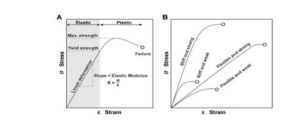 A pair of reviews in J. Exp. Bot. covers aspects of seed dormancy and germination. Steinbrecher and Leubner-Metzger (10.1093/jxb/erw428) provide an excellent introduction to materials science including stress-strain curves and Young’s Modulus, which they then apply to an understanding of the biophysics of seed germination. What happens when seeds imbibe water? How does the composition of seed tissues (embryo, endosperm, testa, pericarp) underpin the breaking of the seed coat by the emergence of the radicle? The review also explores the evolutionary history of seed biomechanics and its application towards the development of artificial seeds. Penfield and MacGregor (10.1093/jxb/erw436) start earlier in the process of seed development and review how the maternal environment, for example temperature, affects seed dormancy and germination. Mediators of such effects, including gene networks and hormones, are described.
A pair of reviews in J. Exp. Bot. covers aspects of seed dormancy and germination. Steinbrecher and Leubner-Metzger (10.1093/jxb/erw428) provide an excellent introduction to materials science including stress-strain curves and Young’s Modulus, which they then apply to an understanding of the biophysics of seed germination. What happens when seeds imbibe water? How does the composition of seed tissues (embryo, endosperm, testa, pericarp) underpin the breaking of the seed coat by the emergence of the radicle? The review also explores the evolutionary history of seed biomechanics and its application towards the development of artificial seeds. Penfield and MacGregor (10.1093/jxb/erw436) start earlier in the process of seed development and review how the maternal environment, for example temperature, affects seed dormancy and germination. Mediators of such effects, including gene networks and hormones, are described.


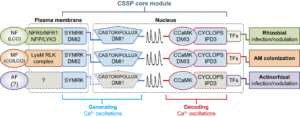 The Common Symbiosis Signaling Pathway (CSSP) conveys the perception of endosymbionts (rhizobia or mycorrhizal fungi) at the plasma membrane to the nucleus to initiate transcriptional responses. Calcium oscillations are core to the CSSP, whether the endosymbiont is fungal or bacterial. Barker et al. review the molecular players involved in the CSSP, with a focus on ongoing efforts to understand the contribution of calcium oscillations. They also describe new evidence that a third symbiotic partnership, that between Frankia bacteria and their
The Common Symbiosis Signaling Pathway (CSSP) conveys the perception of endosymbionts (rhizobia or mycorrhizal fungi) at the plasma membrane to the nucleus to initiate transcriptional responses. Calcium oscillations are core to the CSSP, whether the endosymbiont is fungal or bacterial. Barker et al. review the molecular players involved in the CSSP, with a focus on ongoing efforts to understand the contribution of calcium oscillations. They also describe new evidence that a third symbiotic partnership, that between Frankia bacteria and their 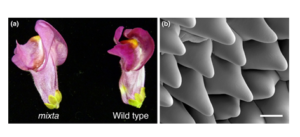 Flowers use a variety of strategies to attract pollinators and ensure successful pollination, including color and scent. Moyroud and Glover review some of the less familiar strategies including physical alterations to reflected light. As one example, conical epidermal cells on snapdragon flower petals focus and scatter light, enhancing petal coloration. Other petals appear glossy due to particularly flat epidermal cells, and still others have small structures that diffract light and so produce iridescence. The authors also describe floral tricks such as spring-loaded anthers that ensure pollen gets deposited onto the visiting pollinators. New Phytol.
Flowers use a variety of strategies to attract pollinators and ensure successful pollination, including color and scent. Moyroud and Glover review some of the less familiar strategies including physical alterations to reflected light. As one example, conical epidermal cells on snapdragon flower petals focus and scatter light, enhancing petal coloration. Other petals appear glossy due to particularly flat epidermal cells, and still others have small structures that diffract light and so produce iridescence. The authors also describe floral tricks such as spring-loaded anthers that ensure pollen gets deposited onto the visiting pollinators. New Phytol. 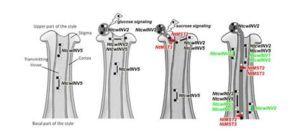 A germinated pollen grain extends a pollen tube through the stigma and style of the flower to deliver two sperm cells to an ovule. Tip-directed growth of the pollen tube requires a large energy input, but how does the pollen tube obtain energy while growing through the flower tissues? Goetz et al. investigated the roles of extracellular cell wall invertase (cwINV) enzymes in supplying energy to the growing pollen tube in N. tabacum. cwINVs break down sucrose into hexose sugars that can be transported into the pollen tube. In tobacco pollen, NtcwINV2 is postulated to regulate NtcwINV1 for control of sucrose breakdown, and RNA transcript levels for both NtcwINV1 and NtcwINV2 peaked in pollinated pistils. The authors found separate pollen tube import pathways for sucrose and hexose sugars formed by cwINV cleavage of sucrose, which are supported by in vitro pollen germination assays indicating glucose stimulates pollen germination while sucrose stimulates pollen tube extension. To show how hexoses can be imported into the pollen tube, the authors characterize two hexose transporters, NtMST2 and NtMST3. With in situ hybridization, NtMST2 and NtMST3 were detected in growing pollen tubes, and their expression patterns overlap with NtcwINV2. The authors present a model for NtcwINV enzymes and NtMST transporters cooperatively regulating the availability of sugars for pollen germination and tube growth. (Summary by
A germinated pollen grain extends a pollen tube through the stigma and style of the flower to deliver two sperm cells to an ovule. Tip-directed growth of the pollen tube requires a large energy input, but how does the pollen tube obtain energy while growing through the flower tissues? Goetz et al. investigated the roles of extracellular cell wall invertase (cwINV) enzymes in supplying energy to the growing pollen tube in N. tabacum. cwINVs break down sucrose into hexose sugars that can be transported into the pollen tube. In tobacco pollen, NtcwINV2 is postulated to regulate NtcwINV1 for control of sucrose breakdown, and RNA transcript levels for both NtcwINV1 and NtcwINV2 peaked in pollinated pistils. The authors found separate pollen tube import pathways for sucrose and hexose sugars formed by cwINV cleavage of sucrose, which are supported by in vitro pollen germination assays indicating glucose stimulates pollen germination while sucrose stimulates pollen tube extension. To show how hexoses can be imported into the pollen tube, the authors characterize two hexose transporters, NtMST2 and NtMST3. With in situ hybridization, NtMST2 and NtMST3 were detected in growing pollen tubes, and their expression patterns overlap with NtcwINV2. The authors present a model for NtcwINV enzymes and NtMST transporters cooperatively regulating the availability of sugars for pollen germination and tube growth. (Summary by 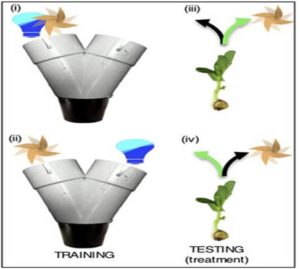 Animals can easily establish associations between environmental cues and food sources, acquiring conditional information that guides their foraging behaviour and in consequence, their survival. Proving whether plants show association or conditional learning has been tricky, but fortunately for us, Gagliano et al. have come with a way to show that learning by association is, in fact, more ubiquitous than thought in the tree of life. With a couple of extremely simple but clever experiments, the authors unequivocally show that pea seedlings previously trained with a conditional stimulus can predict a future source of light, prevailing over innate phototropism responses. This conditioned response is mostly evident when the training overlaps the subjective day, suggesting that this behavior is regulated by metabolic demands. And people say plants are boring… I don’t think so! (Summary by
Animals can easily establish associations between environmental cues and food sources, acquiring conditional information that guides their foraging behaviour and in consequence, their survival. Proving whether plants show association or conditional learning has been tricky, but fortunately for us, Gagliano et al. have come with a way to show that learning by association is, in fact, more ubiquitous than thought in the tree of life. With a couple of extremely simple but clever experiments, the authors unequivocally show that pea seedlings previously trained with a conditional stimulus can predict a future source of light, prevailing over innate phototropism responses. This conditioned response is mostly evident when the training overlaps the subjective day, suggesting that this behavior is regulated by metabolic demands. And people say plants are boring… I don’t think so! (Summary by 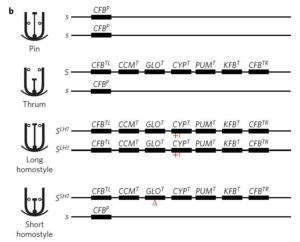 Self-fertilization in Primula is avoided by the production of two flower forms (morphs), one with a long style in which the stigma is elevated above the anthers (the L morph or pin) and one with a short style in which the anthers are well above the stigma (the S morph or thrum), although there are also populations in which the anther and stigma are of the same height (either as long homostyle or short homostyle). The S locus is a complex genetic locus known to specify the different flower forms. Li et al. showed that thrums (S/s) carry a form of the S locus that has more genes than the form found in pins (s/s). One of the thrum-specific genes CYP encodes a cytochrome P450 enzyme shown recently by Huu et al to break down brassinosteroid hormones, thus accounting for the shorter styles in the thrums. Li et al. also show that homostyles arise from alterations in the S locus, specifically in the CYP or GLO genes. eLIFE
Self-fertilization in Primula is avoided by the production of two flower forms (morphs), one with a long style in which the stigma is elevated above the anthers (the L morph or pin) and one with a short style in which the anthers are well above the stigma (the S morph or thrum), although there are also populations in which the anther and stigma are of the same height (either as long homostyle or short homostyle). The S locus is a complex genetic locus known to specify the different flower forms. Li et al. showed that thrums (S/s) carry a form of the S locus that has more genes than the form found in pins (s/s). One of the thrum-specific genes CYP encodes a cytochrome P450 enzyme shown recently by Huu et al to break down brassinosteroid hormones, thus accounting for the shorter styles in the thrums. Li et al. also show that homostyles arise from alterations in the S locus, specifically in the CYP or GLO genes. eLIFE 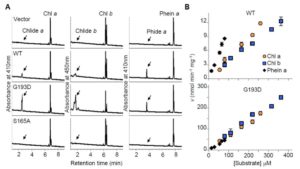 Chlorophyll has an aliphatic phytol side chain that anchors it to light-harvesting complexes. During senescence, chlorophyll is degraded first by the enzymatic removal of Mg to produce pheophytin, which is dephytlated by pheophytinase. Through the identification of a mutant allele with elevated enzymatic activity, Lin et al. have now identified an enzyme, CLD1, that directly dephytylates chlorophyll. The authors propose that CLD1 is involved in the steady-state turnover of chlorophyll in green tissues, and is required for thermotolerance to moderately high temperatures. Plant Cell
Chlorophyll has an aliphatic phytol side chain that anchors it to light-harvesting complexes. During senescence, chlorophyll is degraded first by the enzymatic removal of Mg to produce pheophytin, which is dephytlated by pheophytinase. Through the identification of a mutant allele with elevated enzymatic activity, Lin et al. have now identified an enzyme, CLD1, that directly dephytylates chlorophyll. The authors propose that CLD1 is involved in the steady-state turnover of chlorophyll in green tissues, and is required for thermotolerance to moderately high temperatures. Plant Cell 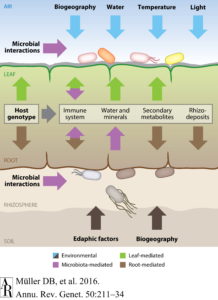 Terrestrial plants are hosts to diverse types of microbes, predominantly bacteria, that affect plant health and growth in numerous ways. The major types of plant microbiota include plant pathogens, arbuscular mycorrhizal (AM) fungi, endophytes (residing within plant tissues), epiphytes (residing on plant surfaces), etc. Müller et al. review various aspects of plant microbiota research. Phylogenetic research suggests that in spite of some differences, the microbial communities on above- and belowground organs typically exhibit a defined taxonomic structure composed of mainly Proteobacteria, Actinobacteria, Bacteroidetes, and Firmicutes. A holistic understanding of entire plant microbiomes can be gained by an integration of various omics data. Insights into how host genotype affects bacterial community establishment come from Synthetic Communities (SynComs), involving gnotobiotic systems in which a plant grown under microbe-free conditions can be experimentally inoculated. A better understanding of the various plant host-microbe interactions taking place at a systems level could help with microbiome applications such as improved plant health and phytoremediation. (Summary by
Terrestrial plants are hosts to diverse types of microbes, predominantly bacteria, that affect plant health and growth in numerous ways. The major types of plant microbiota include plant pathogens, arbuscular mycorrhizal (AM) fungi, endophytes (residing within plant tissues), epiphytes (residing on plant surfaces), etc. Müller et al. review various aspects of plant microbiota research. Phylogenetic research suggests that in spite of some differences, the microbial communities on above- and belowground organs typically exhibit a defined taxonomic structure composed of mainly Proteobacteria, Actinobacteria, Bacteroidetes, and Firmicutes. A holistic understanding of entire plant microbiomes can be gained by an integration of various omics data. Insights into how host genotype affects bacterial community establishment come from Synthetic Communities (SynComs), involving gnotobiotic systems in which a plant grown under microbe-free conditions can be experimentally inoculated. A better understanding of the various plant host-microbe interactions taking place at a systems level could help with microbiome applications such as improved plant health and phytoremediation. (Summary by 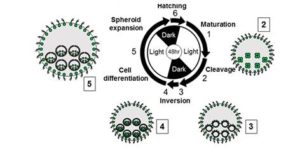 Matt and Umen introduce the multicellular green alga Volvox carteri as a model for developmental studies. They provide an overview of embryonic patterning including the role of asymmetric cell divisions, inversion, (a process with some similarities to vertebrate gastrulation), and the role of cell size in cell fate. They conclude with a summary of genetic and other tools for the study of Volvox biology, as well as a list of open questions. This would be a very nice paper for students studying development, as Volvox is a less familiar but nonetheless interesting model species. Devel. Biol.
Matt and Umen introduce the multicellular green alga Volvox carteri as a model for developmental studies. They provide an overview of embryonic patterning including the role of asymmetric cell divisions, inversion, (a process with some similarities to vertebrate gastrulation), and the role of cell size in cell fate. They conclude with a summary of genetic and other tools for the study of Volvox biology, as well as a list of open questions. This would be a very nice paper for students studying development, as Volvox is a less familiar but nonetheless interesting model species. Devel. Biol.